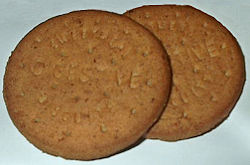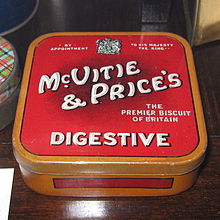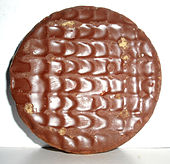- Digestive biscuit
-
A digestive biscuit, sometimes referred to as a sweet-meal biscuit, is a semi-sweet biscuit originated in the United Kingdom and popular worldwide. The term 'digestive' is derived from the belief that they had antacid properties due to the use of sodium bicarbonate when they were first developed.[1] Historically, some producers used diastatic malt extract to 'digest' some of the starch that existed in flour prior to baking.[2][3]
Contents
History
Digestives are known at least as far back as advertisements for Huntley & Palmers in 1876, with a recipe being given in Cassell's 'New Universal Cookery Book' of 1894.[4][clarification needed] Even further back, one 1851 issue of The Lancet London advertised at least two sources of digestive biscuits, one such baker, William Hill, offered "brown meal digestive biscuits".[5] At the time, it was asserted grain millers knew only of bran and endosperm.[6] After 10% of the grain's coarser outer-bran coat was removed, and because the innermost 70% of pure endosperm was reserved for other uses, brown meal, representing only 20% of the whole grain, remained, and was itself composed of about 15% fine bran and 85% white flour.[7] By 1912 it was more widely known that brown meal included the germ, which lent a characteristic sweetness.[8]
In 1889, John Montgomerie of Scotland filed a U.S. patent application which was granted in 1890. This patent asserted a prior patent existed in England dated 1886. The U.S. patent titled Making Malted Bread included instructions for the manufacture of digestive biscuits. Montgomerie claimed this saccharification process would make "nourishing food for people of weak digestion ..."[9]
Despite rumours[10] that it is illegal for them to be sold under their usual name in the United States,[11] they are in fact widely available in imported food sections of grocery stores and by mail order.[12] In the United States, buying digestive biscuits may require a visit to an international market or you can order them from international retailers (such as world.com) that have an Internet presence. (http://www.livestrong.com/article/461359-what-are-digestive-biscuits/#ixzz1bFl0icQ3)[1]</ref>
Ingredients
The typical digestive biscuit contains coarse brown wheat flour (which gives it its distinctive texture and flavour), sugar, malt extract, vegetable oil, wholemeal, raising agents (usually sodium bicarbonate, tartaric acid and malic acid) and salt.[13] Dried whey, oatmeal, cultured skimmed milk and/or emulsifiers such as E472e may also be added in some varieties. Digestive biscuits may not be suitable for nut or soya allergy sufferers due to certain production methods. Careful reading of packaging and or contact with manufacturers should be performed to satisfy any concerns regarding cross contamination.
Digestive biscuits outside of the United States, like many foods, are not reliant on the addition of high-fructose corn syrup (sometimes referred to as "glucose-fructose syrup"), and hence may add more natural sugar instead, such as in New Zealand[14] or in the United Kingdom.[15]
A digestive biscuit averages around 70 calories, although this sometimes varies according to the factors involved in its production.
Consumption
Digestive biscuits are frequently eaten with tea or coffee. Sometimes, the biscuit is dunked into the tea and eaten quickly due to the biscuit's tendency to disintegrate when wet.
In the UK alone, the annual sales of chocolate digestives total about £35 million. This means that each year, 71 million packets of these are sold - and each second 52 biscuits are consumed.[1] Digestives are also popular in food preparation for making into bases for cheesecakes and similar desserts.[16]
Chocolate digestives
Chocolate digestive biscuits also are available, coated on one side with milk, dark or white chocolate. Originally produced by McVitie's in 1925 as the Chocolate Homewheat Digestive, other recent varieties include the basic biscuit with chocolate shavings throughout (chocolate 'chips' within the biscuit mix), or a layer of caramel, mint chocolate, orange-flavoured chocolate,[17] or plain chocolate. American travel writer Bill Bryson described the chocolate digestive as a British masterpiece.[18]
Recipe substitution
In recipes calling for digestive biscuits, it is common to substitute Graham crackers in the United States and Canada. According to Charles Panati, the original Graham cracker is called a "digestive biscuit" in Britain.[19]
See also
References
- ^ a b "United Biscuits - McVitie's Brand History". http://www.unitedbiscuits.co.uk/our-brands.php?rnd=5ccnOA4BBRMw6glGqSVPgqS8XJhQRXHB%2Ba733N159IGIzGxD9kK7FVyhacEQhQAB.
- ^ Chamber's encyclopaedia: a dictionary of universal knowledge, Volume 2. J.B. Lippencott Company. 1888. p. 182. http://books.google.com/books?id=fDtMAAAAMAAJ&pg=PA182#v=onepage&q&f=false. Retrieved 2011 April 7. "Digestive biscuits are prepared in such a manner that they may contain diastase, the nitrogenous transforming matter of malt; but whatever quantity of this substance they may contain in the condition of dough is destroyed in the process of baking."
- ^ Pharmaceutical journal and Transactions. Third. XVII. London. 1887. p. 156. http://books.google.com/books?id=6-ZLKHNCbHoC&pg=PA156#v=onepage&q&f=false. Retrieved 2011 April 8. "A new competitor in this field was Paterson's Extract of Malt, exhibited by the Phoenix Chemical Works, Glasgow; the odour and flavour of this was excellent, and it is said to be rich in diastasic power. Prepared from it was exhibited a series of digestive biscuits, rusks and bread by John Montgomerie, of Glasgow. In making these part of the starch of the flour is changed by being mixed with the malt extract and water and kept for some time at a suitable temperature; the yeast being probably added to another portion of flour and water, to form dough to mix with the above before baking. These biscuits seemed to be appreciated by visitors. Messrs. Hill and Son also exhibited some malted nursery biscuits. Benger's wellknown digestive ferments were well displayed, together with an essence of rennet recently introduced."
- ^ OED
- ^ Thomas Wakely, ed (July 31, 1851). The Lancet [A Journal of British and Foreign medicine, Physiology, Surgery, Chemistry, Criticism, Literature, and News]. 2. London: George Churchill. pp. 24(IA2)-24(IA3). http://books.google.com/books?id=pBhAAAAAcAAJ&pg=PA24-IA2#v=onepage&q&f=false. Retrieved 2011 April 2011.
- ^ John Saunders, ed (1848). The People's journal. IV. London: The People's Journal Office. p. 42(IA1). http://books.google.com/books?id=s1QAAAAAYAAJ&pg=PA42-IA1#v=onepage&q&f=false. Retrieved 2011 April 15. "Professor Johnston remarks that---"The grain of wheat consists of two parts, with which the miller is familiar---the inner grain and the skin that covers it. The inner grain gives the pure wheat flour; the skin when separated, forms the bran.""
- ^ Jacob Bell, ed (1857-58). The Pharmaceutical journal and Transactions. XVII. London: John Churchill. pp. 276–277. http://books.google.com/books?id=kO0KAAAAYAAJ&pg=PA277#v=onepage&q&f=false. Retrieved 2011 April 2011. "The Parisian white bread is prepared with the finest flour (1re marque), which does not contain any bran. If 100 parts wheat yield 70 parts of this flour, the remainder will consist of 10 parts bran and 20 parts coarse brown meal, this latter con-sisting of 3 parts fine bran and 17 parts white flour."
- ^ Percy A. Amos (1912). Processes of flour manufacture. New York, Bombay, and Calcutta: Longman, Green, and Co.. p. 14. http://books.google.com/books?id=KXLzrbmw8u0C&pg=PA14#v=onepage&q&f=false. Retrieved 2011 April 12. "By allowing the germ and all but the outer, coarser layers of broad bran to mix in with the flour, we get the sweet-tasting brown meal producing the brown bread so much in favour amoungst sections of the community."
- ^ U.S. Patent 423,263
- ^ Encounter. http://books.google.com/books?id=BvUmAQAAIAAJ&q=%22digestive+biscuit%22&dq=%22digestive+biscuit%22. Retrieved 2011 April 8. "A govern-ment-appointed group of scientists, the Food Stan-dards Committee, is to study the term "Digestive biscuit", which has been used since the reign of Queen Victoria. The committee is to decide whether the term should be banned on the ground that it implies that the biscuit eats itself."
- ^ QI, Season B, Episode 7, 'Biscuits', In America it is illegal to call them "digestives"
- ^ Cost Plus World Market: Product listing for retail and mail order availability in the United States
- ^ Young, Linda; Cauvain, Stanley P. (2006). Baked Products: Science, Technology and Practice. Wiley-Blackwell. p. 62. ISBN 1-4051-2702-3. http://books.google.com/books?id=6klZ-ZbTTXQC&pg=PA62#v=onepage&q&f=false. Retrieved 2011 April 8.
- ^ Griffins Digestives
- ^ McVities Digestives
- ^ Waitrose: Banoffee Pie
- ^ EnglishTeaStore.com: McVities Milk Chocolate & Orange Digestives 300g Accessed 2008-01-05
- ^ Bryson, Bill. (1996). Notes from a Small Island; William Morrow, ISBN 0688147259
- ^ Panati, Charles (1989). Panati's extraordinary origins of everyday things. San Francisco: Perennial Library. p. 413. ISBN 0-06-096419-7. http://books.google.com/books?id=hI9Weq6q9dEC&pg=PA413#v=onepage&q&f=false. Retrieved 2011 April 8. "The graham cracker originated as a health food, and in Britain it is still known as a "digestive biscuit.""
External links
 Media related to Digestive biscuits at Wikimedia CommonsCategories:
Media related to Digestive biscuits at Wikimedia CommonsCategories:- Biscuits (British style)
- Crackers (food)
- 1892 introductions
- United Biscuits brands
Wikimedia Foundation. 2010.



